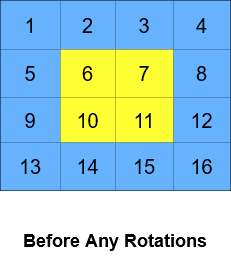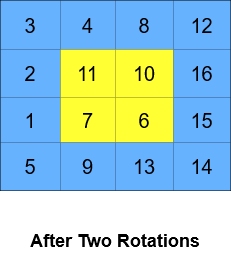Cyclically Rotating a Grid
Problem Statement - link #
You are given an m x n integer matrix grid, where m and n are both even integers, and an integer k.
The matrix is composed of several layers, which is shown in the below image, where each color is its own layer:

A cyclic rotation of the matrix is done by cyclically rotating each layer in the matrix. To cyclically rotate a layer once, each element in the layer will take the place of the adjacent element in the counter-clockwise direction. An example rotation is shown below:

Return the matrix after applying k cyclic rotations to it.
Examples #
Example 1:

Input: grid = [[40,10],[30,20]], k = 1
Output: [[10,20],[40,30]]
Explanation: The figures above represent the grid at every state.
Example 2:



Input: grid = [[1,2,3,4],[5,6,7,8],[9,10,11,12],[13,14,15,16]], k = 2
Output: [[3,4,8,12],[2,11,10,16],[1,7,6,15],[5,9,13,14]]
Explanation: The figures above represent the grid at every state.
Constraints #
m == grid.lengthn == grid[i].length2 <= m, n <= 50- Both
mandnare even integers. 1 <= grid[i][j] <= 50001 <= k <= 10^9
Solutions #
class Solution {
public:
vector<vector<int>> rotateGrid(vector<vector<int>>& grid, int k) {
int n = grid.size();
int m = grid[0].size();
int l=0,u=0,r=m-1,d=n-1;
int level = min(m,n) / 2;
while(level--){
vector<int> temp;
for(int i=l; i<=r; i++)
temp.push_back(grid[u][i]);
for(int i=u+1; i<=d; i++)
temp.push_back(grid[i][r]);
for(int i=r-1; i>=l; i--)
temp.push_back(grid[d][i]);
for(int i=d-1; i>u; i--)
temp.push_back(grid[i][l]);
int tsz = temp.size();
int ti=0;
for(int i=l; i<=r; i++,ti++)
grid[u][i] = temp[(k+ti)%tsz];
for(int i=u+1; i<=d; i++,ti++)
grid[i][r] = temp[(k+ti)%tsz];
for(int i=r-1; i>=l; i--,ti++)
grid[d][i] = temp[(k+ti)%tsz];
for(int i=d-1; i>u; i--,ti++)
grid[i][l] = temp[(k+ti)%tsz];
l++; r--;
u++; d--;
}
return grid;
}
};